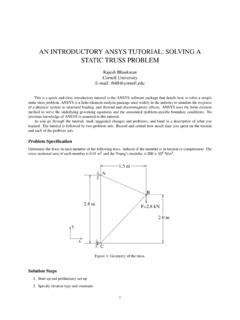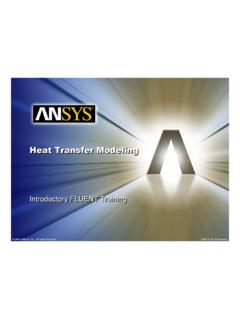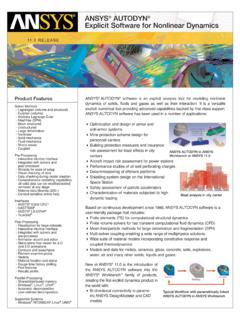Transcription of Calculating and Displaying Fatigue Results - Ansys
1 Calculating and Displaying Fatigue Results The Ansys Fatigue Module has a wide range of features for performing calculations and presenting analysis Results . By Raymond Browell Product Manager New Technologies Ansys , Inc. Al Hancq Development Engineer Ansys , Inc. March 29, 2006 Table of Contents TABLE OF CONTENTS .. 2 LIST OF FIGURES .. 3 INTRODUCTION .. 4 ANALYSIS DECISIONS .. 4 COMMON DECISIONS FOR Fatigue ANALYSIS .. 4 STRESS LIFE VS. STRAIN LIFE .. 5 COMMON DECISIONS TO BOTH TYPES OF Fatigue ANALYSIS .. 7 TYPES OF CYCLIC LOADING .. 10 Constant amplitude, Proportional 10 Constant Amplitude, Non-Proportional Loading .. 11 Non-constant amplitude, Proportional Loading .. 12 Non-constant amplitude, Non-Proportional Loading .. 13 MEAN STRESS CORRECTION .. 13 Mean Stress Corrections for Stress Life .. 13 Mean Stress Corrections for Strain Life .. 15 MULTIAXIAL STRESS CORRECTION FACTORS .. 17 Fatigue MODIFICATIONS.
2 18 Value of Infinite Life .. 18 Fatigue Strength Factor .. 20 Loading Scale Factor .. 20 Stress Life Interpolation .. 21 TYPES OF Results .. 22 GENERAL Fatigue Results .. 23 Fatigue Life .. 23 Fatigue Damage .. 24 Fatigue Safety Factor .. 25 Biaxiality Indication .. 26 Fatigue Sensitivity .. 27 Rainflow Matrix Chart (Beta for Strain Life at ) .. 28 Damage Matrix Chart (Beta for Strain Life at ) .. 29 Fatigue Results UNIQUE TO STRESS LIFE Fatigue ANALYSIS .. 30 Equivalent Alternating Stress .. 30 Fatigue Results UNIQUE TO STRAIN LIFE Fatigue ANALYSIS .. 31 Hysteresis .. 31 CONCLUSION .. 32 TYPICAL USE CASES .. 33 CONNECTING ROD UNDER FULLY REVERSED LOADING .. 33 CONNECTING ROD UNDER RANDOM LOADING .. 36 UNIVERSAL JOINT UNDER NON-PROPORTIONAL LOADING .. 38 Fatigue REFERENCES .. 41 REVISION HISTORY .. 42 List of Figures FIGURE 1. SIMPLIFIED Fatigue ANALYSIS DECISION TREE .. 5 FIGURE 2. STRESS LIFE DECISION TREE. INDICATES CAPABILITY AVAILABLE IN THE Ansys Fatigue MODULE.
3 8 FIGURE 3. STRAIN LIFE DECISION TREE. INDICATES CAPABILITY AVAILABLE IN THE Ansys Fatigue MODULE. BETA INDICATES A BETA CAPABILITY AVAILABLE IN THE Ansys Fatigue MODULE.. 9 FIGURE 4. EXAMPLE OF CONSTANT AMPLITUDE LOADING. IN THIS CASE IT IS FULLY REVERSED (+1 TO -1) LOADING.. 10 FIGURE 5. EXAMPLE TREE AND SOLUTION COMBINATION FOR CONSTANT AMPLITUDE, NON-PROPORTIONAL LOADING.. 11 FIGURE 6. EXAMPLE OF NON-CONSTANT AMPLITUDE LOADING.. 12 FIGURE 7. EQUATION AND GRAPHICAL REPRESENTATION OF THE SODERBERG MEAN STRESS CORRECTION FOR STRESS LIFE Fatigue ANALYSIS.. 13 FIGURE 8. EQUATION AND GRAPHICAL REPRESENTATION OF THE GOODMAN MEAN STRESS CORRECTION FOR STRESS LIFE Fatigue ANALYSIS.. 14 FIGURE 9. EQUATION AND GRAPHICAL REPRESENTATION OF THE GERBER MEAN STRESS CORRECTION FOR STRESS LIFE Fatigue ANALYSIS.. 14 FIGURE 10. EXAMPLE OF THE MEAN STRESS CORRECTION DATA BY R-RATIO MEAN STRESS CURVES.. 15 FIGURE 11. EXAMPLE OF THE NO MEAN STRESS CORRECTION FOR STRAIN LIFE Fatigue ANALYSIS.
4 16 FIGURE 12. EXAMPLE OF THE MORROW MEAN STRESS CORRECTION FOR STRAIN LIFE Fatigue ANALYSIS.. 17 FIGURE 13. EXAMPLE OF THE SMITH, WATSON AND TOPPER (SWT) MEAN STRESS CORRECTION FOR STRAIN LIFE Fatigue ANALYSIS.. 17 FIGURE 14. EFFECT OF THE VALUE OF INFINITE LIFE ON Fatigue DAMAGE.. 19 FIGURE 15. EXAMPLE OF AN S-N CURVE DISPLAYED AND INTERPOLATED AS LOG-LOG. SEE FIGURE 9 FOR A SEMI-LOG DISPLAY.. 21 FIGURE 16. CONTOUR PLOT OF Fatigue LIFE OVER THE WHOLE MODEL.. 23 FIGURE 17. CONTOUR PLOT OF Fatigue DAMAGE OVER THE WHOLE MODEL.. 24 FIGURE 18. CONTOUR PLOT OF Fatigue SAFETY FACTOR OVER THE WHOLE MODEL.. 25 FIGURE 19. CONTOUR PLOT OF BIAXIALITY INDICATION OVER THE WHOLE MODEL.. 26 FIGURE 20. EXAMPLE OF A Fatigue SENSITIVITY CURVE.. 27 FIGURE 21. RAINFLOW MATRIX CHART SHOWING PERCENT OF OCCURANCE.. 28 FIGURE 22. DAMAGE MATRIX CHART SHOWING PERCENT DAMAGE.. 29 FIGURE 23. CONTOUR PLOT OF EQUIVALENT ALTERNATING STRESS.. 30 FIGURE 24. EXAMPLE OF A HYSTERESIS DIAGRAM FOR A ZERO BASED LOAD CASE (SHOWN ABOVE HYSTERESIS CURVE).
5 31 Introduction While many parts may work well initially, they often fail in service due to Fatigue failure caused by repeated cyclic loading. Characterizing the capability of a material to survive the many cycles a component may experience during its lifetime is the aim of Fatigue analysis. In a general sense, Fatigue Analysis has three main methods, Strain Life, Stress Life, and Fracture Mechanics; the first two being available within the Ansys Fatigue Module. The Stain Life approach is widely used at present. Strain can be directly measured and has been shown to be an excellent quantity for characterizing low-cycle Fatigue . Strain Life is typically concerned with crack initiation, whereas Stress Life is concerned with total life and does not distinguish between initiation and propagation. In terms of cycles, Strain Life typically deals with a relatively low number of cycles and therefore addresses Low Cycle Fatigue (LCF), but works with high numbers of cycles as well.
6 Low Cycle Fatigue usually refers to fewer than 105 cycles. Stress Life is based on S-N curves (Stress Cycle curves) and has traditionally dealt with relatively high numbers of cycles and therefore addresses High Cycle Fatigue (HCF), greater than 105 cycles inclusive of infinite life. Fracture Mechanics starts with an assumed flaw of known size and determines the crack s growth as is therefore sometimes referred to as Crack Life . Facture Mechanics is widely used to determine inspection intervals. For a given inspection technique, the smallest detectable flaw size is know. From this detectable flaw size we can calculate the time required for the crack to grow to a critical size. We can then determine our inspection interval to be less than the crack growth time. Sometimes, Strain Life methods are used to determine crack initiation with Fracture Mechanics used to determine the crack life. In this situation, crack initiation plus crack life equals the total life of the part.
7 Analysis Decisions Common Decisions for Fatigue Analysis There are 5 common input decision topics upon which your Fatigue Results are dependent upon. These Fatigue decisions are grouped into the types listed below: Fatigue Analysis Type Loading Type Mean Stress Effects Multiaxial Stress Correction Fatigue Modification Factor Figure 1. Simplified Fatigue Analysis Decision Tree The decision tree in Figure 1 above shows the general flow of decision required to perform a Fatigue analysis. We will now explore each one in detail. Stress Life vs. Strain Life Within the Ansys Fatigue module, the first decision that needs to be made in performing a Fatigue analysis is which type of Fatigue analysis to perform Stress Life or Strain Life. Stress Life is based on empirical S-N curves and then modified by a variety of factors. Stain Life is based upon the Strain Life Relation Equation where the Strain Life Parameters are values for a particular material that best fit the equation to measured Results .
8 The Strain Life Relation requires a total of 6 parameters to define the strain-life material properties; four strain-life parameter properties and the two cyclic stress-strain parameters. The Strain Life Relation equation is shown below: ()()cffbffNNE22''2 += The two cyclic stress-strain parameters are part of the equation below: nKE'/1'22 += Fatigue Analysis Type Loading Type Mean Stress Effects Multiaxial Stress Correction Fatigue Modifications Where: 2 = Total Strain Amplitude = 2 x the Stress Amplitude E = Modulus of Elasticity Nf = Number of Cycles to Failure Nf2 = Number of Reversals to Failure And the parameters required for a Strain Life analysis are: 'f = Fatigue Strength Coefficient B = Fatigue Strength Exponent (Basquin s Exponent) 'f = Fatigue Ductility Coefficient C = Fatigue Ductility Exponent K' = Cyclic Strength Coefficient n' = Cyclic Strain Hardening Exponent Note that in the above equation, total strain (elastic + plastic) is the required input.
9 However, running an FE analysis to determine the total response can be very expensive and wasteful, especially if the nominal response of the structure is elastic. An accepted approach is to assume a nominally elastic response and then make use of Neuber s equation to relate local stress/strain to nominal stress/strain at a stress concentration location. To relate strain to stress we use Neuber s Rule, which is shown below: SeKt2= Where: = Local (Total) Strain = Local Stress Kt = Elastic Stress Concentration Factor e = Nominal Elastic Strain S = Nominal Elastic Stress Thus by simultaneously solving Neuber s equation along with cyclic strain equation, we can thus calculate the local stress/strains (including plastic response) given only elastic input. Note that this calculation is nonlinear and is solved via iterative methods. Also note that Ansys Fatigue uses a value of 1 for K t, assuming that the mesh is refined enough to capture any stress concentration effects.
10 This K t is not be confused with the Stress Reduction Factor option which is typically used in Stress life analysis to account for things such as reliability and size effects. Common Decisions to Both Types of Fatigue Analysis Once the decision on which type of Fatigue analysis to perform, Stress Life or Strain Life, there are 4 other topics upon which your Fatigue Results are dependent upon. Input decisions that are common to both types of Fatigue analyses are listed below: Loading Type Mean Stress Effects Multiaxial Stress Correction Fatigue Modification Factor Within Mean Stress Effects, the available options are quite different. In the following sections, we will explore all of these additional decisions. These input decision trees for both Stress Life and Strain Life are outlined in Figures 1 and 2. Figure 2. Stress Life Decision Tree. Indicates capability available in the Ansys Fatigue Module As can be seen in the Stress Life Decision Tree, we need to make four input decisions to perform a Stress Life analysis.












